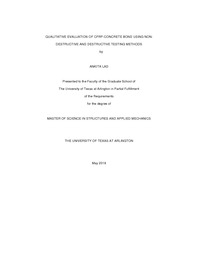
ATTENTION: The works hosted here are being migrated to a new repository that will consolidate resources, improve discoverability, and better show UTA's research impact on the global community. We will update authors as the migration progresses. Please see MavMatrix for more information.
Show simple item record
| dc.contributor.advisor | Yazdani, Nur | |
| dc.creator | Lad, Ankita Anil | |
| dc.date.accessioned | 2018-06-05T17:49:06Z | |
| dc.date.available | 2018-06-05T17:49:06Z | |
| dc.date.created | 2018-05 | |
| dc.date.issued | 2018-05-10 | |
| dc.date.submitted | May 2018 | |
| dc.identifier.uri | http://hdl.handle.net/10106/27429 | |
| dc.description.abstract | CFRP (Carbon Fiber Reinforced Polymer) laminates have been used as externally bonded reinforcements for retrofitting and structural strengthening of concrete structures. The adequacy of the CFRP bonding highly depends on the bond integrity between the concrete and CFRP laminates. Considering the reliability of this bonding technique, premature debonding of laminates from the concrete substrate is a major concern. The bond performance may be influenced directly by various parameters; some of the parameters like surface wetness, surface preparation, presence of voids in concrete substrate and overhead versus on the top installation of CFRP laminate have been discussed in this study. During the installation of the composite system, the bond can be comprised due to poor workmanship or unsuitable environmental conditions; improper cure or installation or surface preparation can cause voids, inclusions, debonds and delamination at the CFRP-substrate level. In this study, assessment of the CFRP-concrete bond for beams strengthened in flexure was carried out. Non-Destructive evaluation methods using Ground Penetrating RADAR, Ultrasound Tomography, Thermography and Schmidt hammer were applied to detect possible disbonds between CFRP-Concrete interfaces. Ground Penetration RADAR was effective in finding the sub-surface defects that affect the bond quality, infrared thermography and ultrasound tomography could detect both surface and subsurface delamination. Further, destructive techniques were executed to determine the type of failure in the CFRP retrofitted beams to correlate it with the quality of the bond. This study may serve as a valuable reference for optimization and inspection of CFRP-Concrete bond at the interface, using Non-destructive testing devices for practical applications. | |
| dc.format.mimetype | application/pdf | |
| dc.language.iso | en_US | |
| dc.subject | CFRP-concrete bond | |
| dc.subject | Non-destructive testing | |
| dc.subject | Delamination | |
| dc.subject | Disbond | |
| dc.subject | Thermography | |
| dc.subject | Ground penetrating radar | |
| dc.subject | Ultrasonic tomography | |
| dc.title | QUALITATIVE EVALUATION OF CFRP-CONCRETE BOND USING NON-DESTRUCTIVE AND DESTRUCTIVE TESTING METHODS | |
| dc.type | Thesis | |
| dc.degree.department | Civil Engineering | |
| dc.degree.name | Master of Science in Civil Engineering | |
| dc.date.updated | 2018-06-05T17:51:14Z | |
| thesis.degree.department | Civil Engineering | |
| thesis.degree.grantor | The University of Texas at Arlington | |
| thesis.degree.level | Masters | |
| thesis.degree.name | Master of Science in Civil Engineering | |
| dc.type.material | text | |
| dc.creator.orcid | 0000-0002-7658-2268 | |
Files in this item
- Name:
- LAD-THESIS-2018.pdf
- Size:
- 4.539Mb
- Format:
- PDF
This item appears in the following Collection(s)
Show simple item record


